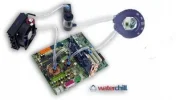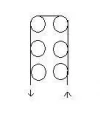Interesting points raised. I really think a PC in a fridge (or a freezer) would work very well.
My objectives for this would be:
1. No dust in the PC or any of its internal components. Dust causes heat to accumulate and also makes the fans more noisy.
2. Run the PC at a low temperature to allow reliable overclocking.
The PC does not need to be modified; just put the whole case in the fridge. A remote power switch would be handy as would external removable media drives.
Out-of-scope:
No need to be able to serve cool drinks. Every time the box is opened, moisture and dust are introduced. However, a more expensive 'frost-free' fridge/freezer might allow this.
Would prefer a glass front door so the lights etc. show.
Provided the fridge is not opened more than say once a day, I doubt that condensation will be a problem. Unlikely to open it more than a few times a year anyway. The reasons why there won't be a condensation problem are:
1. The PC will always be the warmest thing in the fridge, so condensation will go there last.
2. The fridge will always be the coolest thing, so water-vapour will condense where it's safe, drip down to the drainage system (which most fridges have) and out to the evaporator (sitting on the hot compressor). That is why (unlesss the door-seal is damaged) the inside of a fridge is always dry. Definitely drier than the outside.
3. The PC fans will all be working so you would need a huge amount of moisture for it to settle.
The only time condensation would happen is if the (cold) PC is removed from the fridge. To avoid this, just switch off the fridge, switch off the PC ( so it doesn't overheat ) and allow it to warm-up to near room temperature; (air would be even drier now) then open the fridge door for a while... should be fine.
Would need to drill a hole ( at a safe location in the back of the fridge ) for the cables... re-seal with expanding foam, etc.
I doubt that a wine-cooler will be powerful enough for this... a freezer is probably best (because the whole system would be able to work harder and not give up) but with its thermostatic switch modified such that the unit runs a bit above freezing... placing even less load on the compressor etc.
For even cooler and more efficient operation create a fanless CPU-heat-pipe, similar in design to say the one at
http://www.silentpcreview.com/article114-page1.html
but if possible connect it between the CPU and the chilling metal component inside the fridge / freezer (it could perhaps be soldered to the cold metal tubing in the freezer).



